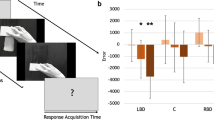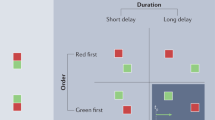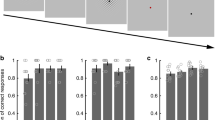Abstract
The organization of the time frames for perceiving, generating, and updating information in the CNS has as of yet received little attention despite its elementary character for human behavior. We investigated temporal epochs in perceiving, acting, and updating in patients with anterior and posterior lesions of the left and right hemisphere, in patients with lesions in the left hemisphere without aphasia, and in healthy controls. Three temporal ranges, 30, 300, and 3000 ms, were assessed with different psychophysical paradigms. Prolongation of the temporal perception of order (30 ms) was most pronounced with left posterior lesions, of repetitive action (300 ms) with left anterior lesions, and updating (3000 ms) with left and right anterior lesions. Temporal deficits are group as well as parameter specific. Our results support the notion of coordinated coexistence of different temporal mechanisms.
Similar content being viewed by others
Author information
Authors and Affiliations
Rights and permissions
About this article
Cite this article
von Steinbüchel, N. Temporal ranges of central nervous processing: clinical evidence. Exp Brain Res 123, 220–233 (1998). https://doi.org/10.1007/s002210050564
Issue Date:
DOI: https://doi.org/10.1007/s002210050564




